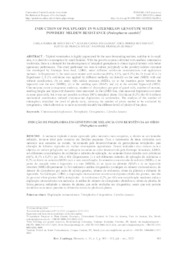Induction of polyploidy in watermelon genotype with powdery mildew resistance (Podosphaera xanthii).
Induction of polyploidy in watermelon genotype with powdery mildew resistance (Podosphaera xanthii).
Author(s): SILVA, C. M. de J.; DIAS, R. de C. S.; SANTOS, J. S. dos; SOUZA, F. de F.; MELO, N. F. de
Summary: Triploid watermelon is highly appreciated by the most demanding markets, and due to its small size, it is ideal for consumption by small families. With the growth in areas cultivated with seedless watermelon worldwide, there is a demand for the development of tetraploid germplasm to obtain triploid hybrids with better agronomic performance. This study performed two tests to induce polyploidy in the powdery mildew?resistant line developed by Embrapa Semi-Arid, LDRO, under different colchicine concentrations and application methods. In Experiment 1, the seeds were treated with colchicine (0.0%, 0.1%, and 0.2%) for 24 h and 48 h. In Experiment 2, 0.2% colchicine was applied by different methods: (a) directly on the seed (MDS) with and without scarification, (b) on seeds with radicle emission (MER), (c) at the insertion point between the hypocotyl and the root (MIHR), (d) at the seedling apex (MAP), and (e) in the inverted hypocotyl (MHI). Chromosome count (cytogenetic analysis), number of chloroplasts per pair of guard cells, number of stomata, seedling height, and hypocotyl diameter were measured. In the LDRO line, chromosomal duplication occurred in some plant cells, but it was not possible to obtain 100% tetraploid plants. Colchicine (0.2%) for 48 h without mechanical scarification induced chromosomal duplication in watermelon. The analysis of the number of chloroplasts identified the level of ploidy early, reducing the number of plants needed to be evaluated by cytogenetics, which allowed us to more accurately identify the different levels of ploidy of the plant.
Publication year: 2022
Types of publication: Journal article
Unit: Embrapa Semi-arid Region
Observation
Some of Embrapa's publications are published as ePub files. To read them, use or download one of the following free software options to your computer or mobile device. Android: Google Play Books; IOS: iBooks; Windows and Linux: Calibre.
Access other publications
Access the Agricultural Research Database (BDPA) to consult Embrapa's full library collection and records.
Visit Embrapa Bookstore to purchase books and other publications sold by Embrapa.

